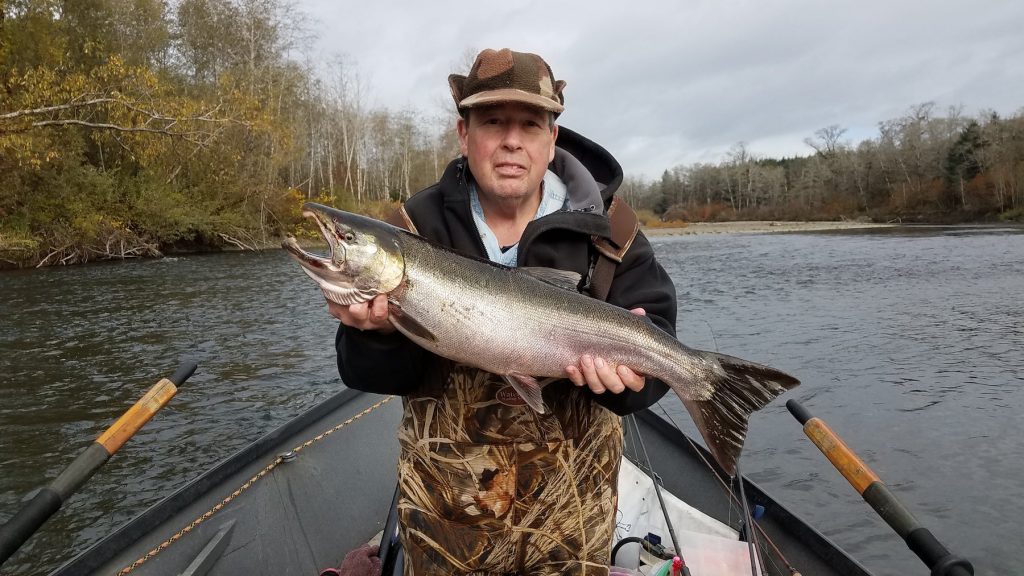No Boat-fishing-ban Exemptions For Disabled Coastal Steelheaders
Editor’s note: Updated Dec. 22, 2020, 1 p.m., with further comments from Mark Gavin in the third paragraph from bottom and clarification that boats are still allowed for transportation only on the affected rivers.
WDFW has revised its statement on accommodating disabled anglers who want to pursue coastal steelhead out of a boat this season – from directing them how to apply for an exemption to now pointing them to other waters with ADA access instead.
Angler Mark Gavin, 66, who says his range of motion is extremely limited, was turned down late last week when he made his request to be allowed to fish from a floating device on rivers such as the Quillayute, Humptulips, Wynoochee and others.
“In this new era of social consciousness, I find the WDFW’s policy of not recognizing disabilities and failure to follow the requirements of the ADA hard hearted and illegal,” Gavin said via email.

Hard hearted for sure, and a “hard one to swallow,” acknowledged a high-ranking agency official this stormy day, but also not likely to be reversed anytime soon.
“Based on our conservation concerns, we’re not allowing any fishing whatsoever from a boat,” said Kelly Cunningham, WDFW Fish Program director. “In terms of ADA, we maintain ADA sites and we’re pointing folks to those areas.”

That marks a change from earlier this month when WDFW initially posted a statement on its Medium blog that pointed anglers like Gavin to the process for applying for exceptions to the rule.
“DFW makes every effort to provide angling opportunities for people of all abilities. Disability access concerns may be addressed via a request for reasonable accommodation. More information about this process is available on our Requests for Title VI / ADA services web page.”
A layman’s reading suggests optimism that legitimate applications would be accepted and approved.
But that same post has now been updated to read:
“Due to the dire situation of these wild runs, we’ve had to make extremely difficult decisions that will help preserve fish for the future. To support conservation of these wild runs, fishing by boat won’t be possible this season.“
“We maintain information on other ADA-accessible water access sites and other boat-accessible locations on our website and would encourage those interested to make use of that information to plan alternate trips. Many of these locations are not expected to be impacted by the current low forecast numbers, though we understand that these opportunities may differ from your normal experience.“
Many of those other locations are places to fish for rainbow trout, which are and aren’t the same as steelhead or fishing for steelhead.
No boat fishing was the major change made to the winter fishery due to below-escapement wild steelhead forecasts for a number of South and Central Coast rivers.
(Note that boats can still be used for transportation on the coastal rivers.)
Plugging, side drifting and bobber dogging and other techniques used out of drift boats, pontoons or jet sleds are just much more effective than fishing off the bank.
Spurring the change were predictions that the Chehalis would come in 2,000 fish below spawning goals, and be underneath that mark for the fifth time in five years; the Queets/Clearwater 637 fewer; Humptulips 534; and Willapa 344.
Along with other measures such as banning bait, earlier closures and mandating one single barbless hook only, this season’s catch is expected to be reduced by more than half and help the runs meet management goals.
“We put those rules in effect for one reason and one reason only: the state of coastal steelhead coastwide and to offer fisheries that would meet management objectives,” said WDFW’s Cunningham. “We needed the rules to guarantee us less fish would be caught.”
Fair enough that the agency is trying to get as many fish back on the spawning grounds after several down years following the Blob, the marine heat wave, but why the changing apparent stance on accommodating disabled anglers?
“It’s fair to say that when we started looking at it, we needed to make a policy call,” said Cunningham. “This came up late last week,” i.e., after that initial Medium post from Dec. 9.
He said internal debate revealed “a lot of challenges, enforcement and otherwise.”
It was all disappointing to Gavin, the disabled angler who says he has undergone “nine serious leg operations including two hip and one knee replacement.”
He says that he and others like him can’t fish from the bank for steelhead very effectively, but doing so out of a boat is also quite hard for him.
“Getting in a drift boat is very difficult as my replaced knee does not bend enough to get over the side,” Gavin said. “It requires moving everything out of the way and I kinda pull myself in and flop over the side. Once I am in, I almost never get out until the end of the day due to pain and effort involved.”
WDFW does have a robust program for disabled hunters to get afield, including ADA-friendly hunting blinds and cooperative road access.
Gavin was frustrated that disabled steelheaders – as well as salmon anglers on rivers with late coho – didn’t have similar options to fish out of boats on coastal rivers this season.
In subsequent comments after this blog was posted, Gavin stated that allowing disabled anglers to fish out of an anchored or beached boat – negating the need to climb in and out of the craft to fish from shore – would be a reasonable accommodation on WDFW’s part, but that the agency pointing to other waters instead “is clearly not.”
As it stands, there is only one possible exception, according to Cunningham: for terminally ill anglers, like how the Game Division grants special permits to hunters about to die.
“We would still consider something like that, but that’s where we’re drawing the line,” he said.
